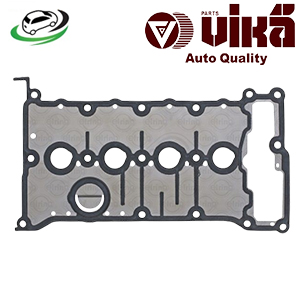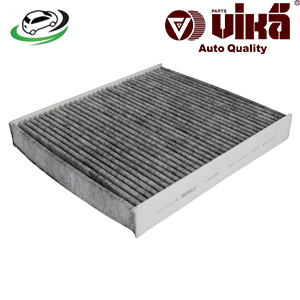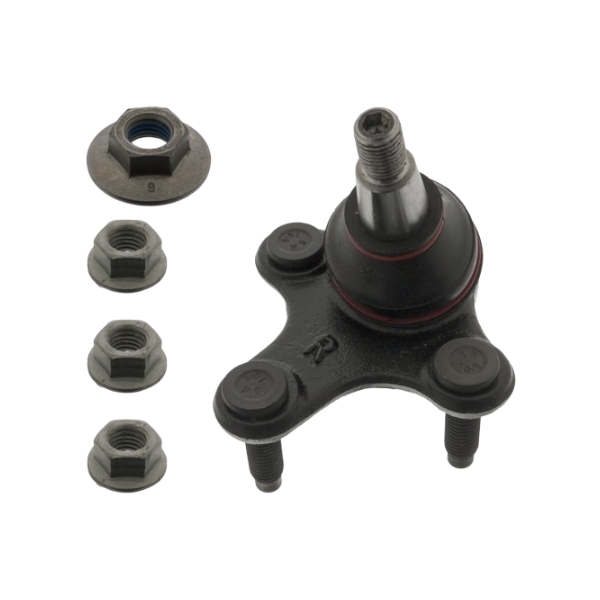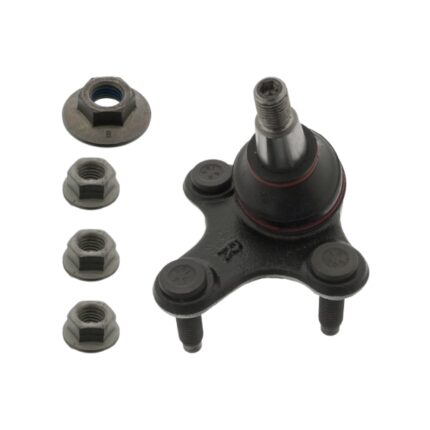Get Audi A3 1.8 TFSI Front Right Ball joint Kit 3C0407366AS1 in Kenya
A ball joint is a critical component in a vehicle’s suspension system. It serves as a pivot point between the wheel and the suspension, allowing for smooth and controlled movement of the vehicle’s wheels. This guide provides an in-depth look at the ball joint’s design, function, types, benefits, maintenance, and replacement.
Design and Function
Design:
A ball joint typically consists of the following components:
- Ball Stud: The ball-shaped end of the ball joint that fits into the socket. It is usually made of high-strength steel to withstand stress and wear.
- Socket: The housing that encases the ball stud. It is often made of steel or a durable synthetic material.
- Boot or Dust Cover: A rubber or synthetic cover that protects the ball joint from dirt, debris, and moisture. This cover helps maintain lubrication and prevent premature wear.
- Grease Fitting: Some ball joints come with a grease fitting (or zerk fitting) to allow for periodic lubrication.
- Retaining Ring: Keeps the ball joint components in place and ensures proper alignment.
Function:
The primary functions of a ball joint are:
- Allowing Movement: Provides a flexible connection that allows for the movement and articulation of the suspension system. This enables the wheels to move up and down and turn left and right.
- Maintaining Alignment: Ensures proper alignment of the steering and suspension components, which is crucial for handling and vehicle stability.
- Absorbing Shocks: Helps absorb and dampen road shocks and vibrations, contributing to a smoother ride.
- Supporting Load: Carries a significant portion of the vehicle’s weight and suspension loads, including the weight of the vehicle and forces from acceleration, braking, and cornering.
Types of Ball Joints
1. Upper Ball Joints:
- Description: Located at the top of the suspension assembly, connecting the control arm to the steering knuckle.
- Advantages: Common in vehicles with independent front suspension systems, providing crucial articulation and support.
2. Lower Ball Joints:
- Description: Positioned at the bottom of the suspension assembly, connecting the lower control arm to the steering knuckle.
- Advantages: Often carries a larger load compared to upper ball joints and is critical for handling and stability.
3. Press-in Ball Joints:
- Description: Installed by pressing the ball joint into a socket or housing. Often used in older vehicles or specific designs.
- Advantages: Can be less expensive and simpler to replace in certain applications.
4. Bolt-on Ball Joints:
- Description: Attached to the suspension assembly using bolts and nuts. Easier to replace compared to press-in types.
- Advantages: Allows for straightforward replacement and adjustment in many modern vehicles.
5. Adjustable Ball Joints:
- Description: Feature an adjustable design that allows for fine-tuning of the suspension alignment.
- Advantages: Provides the ability to adjust alignment settings, which can be beneficial for performance tuning or correction.
Benefits
1. Enhanced Steering Control:
- Precision Movement: Ensures smooth and precise movement of the suspension and steering components, contributing to accurate steering response.
- Handling Stability: Helps maintain proper alignment and handling characteristics, improving vehicle stability and control.
2. Improved Ride Comfort:
- Shock Absorption: Absorbs road shocks and vibrations, resulting in a smoother and more comfortable ride for passengers.
- Reduced Noise: Helps to minimize road noise and vibrations transmitted to the cabin.
3. Durability:
- Robust Construction: Designed to withstand significant stress and wear, contributing to long-lasting performance.
- Protective Boot: The boot or dust cover helps to keep dirt and moisture out, extending the lifespan of the ball joint.
4. Suspension Performance:
- Articulation: Allows for proper movement and articulation of the suspension system, enhancing overall vehicle performance and handling.
Signs of a worn out Ball Joint
1. Unusual Noises
Clunking or Clicking Sounds:
- Description: When driving over bumps, potholes, or rough terrain, you may hear clunking, knocking, or clicking noises coming from the front suspension area.
- Cause: These noises often result from excessive play in the ball joint, allowing the suspension components to move more than they should.
2. Steering Issues
Loose or Wandering Steering:
- Description: The steering may feel loose or less responsive, making it harder to keep the vehicle in a straight line or causing it to drift or wander on the road.
- Cause: Worn ball joints can affect the alignment of the steering system, leading to these symptoms.
Steering Wheel Vibration:
- Description: You may feel vibrations in the steering wheel, especially at higher speeds or when driving over uneven surfaces.
- Cause: A worn ball joint can cause the wheels to become misaligned or move unevenly, leading to vibrations.
3. Uneven Tire Wear
Inner or Outer Edge Wear:
- Description: Inspect your tires for uneven wear patterns, such as more wear on the inner or outer edges.
- Cause: Misalignment due to a worn ball joint can cause the tires to wear unevenly. This is often more noticeable on the front tires.
4. Suspension Problems
Excessive Play or Movement:
- Description: When checking the ball joints manually, you may notice excessive play or movement. This can be tested by lifting the vehicle and moving the wheel vertically and horizontally.
- Cause: A worn ball joint will have more movement than normal, indicating that it can no longer hold the suspension components firmly in place.
Uneven Suspension:
- Description: The vehicle may appear to sit unevenly or have one side lower than the other.
- Cause: A worn ball joint can cause the suspension to sag or become misaligned, leading to an uneven stance.
5. Visual Inspection
Damaged Dust Boot:
- Description: Inspect the dust boot covering the ball joint. Look for cracks, tears, or signs of leaking grease.
- Cause: A damaged dust boot can allow dirt and moisture to enter the joint, accelerating wear and leading to failure.
Rust or Corrosion:
- Description: Check for signs of rust or corrosion around the ball joint.
- Cause: Exposure to the elements can cause the ball joint to corrode, reducing its effectiveness and lifespan.
6. Handling and Ride Quality
Poor Handling:
- Description: The vehicle may handle poorly, with reduced stability, especially during turns or when driving on rough roads.
- Cause: Worn ball joints can affect the suspension’s ability to keep the wheels properly aligned, leading to handling issues.
Rough Ride:
- Description: The ride quality may deteriorate, with the vehicle feeling more bumpy or harsh over uneven surfaces.
- Cause: A worn ball joint can affect the suspension’s ability to absorb shocks and vibrations, leading to a rougher ride.
Maintenance and Troubleshooting
1. Regular Inspection:
- Check for Wear: Inspect the ball joints for signs of wear, such as excessive play, noise, or looseness. Pay attention to any unusual sounds during driving, such as clunking or popping noises.
- Boot Condition: Examine the rubber boot for cracks, tears, or leaks. A damaged boot can lead to contamination and accelerated wear.
2. Lubrication:
- Grease Fitting: If the ball joint has a grease fitting, ensure it is properly lubricated according to the manufacturer’s recommendations. Regular lubrication helps to maintain smooth operation and extend the life of the joint.
- Check for Proper Lubrication: Verify that there is sufficient grease in the joint. Lack of lubrication can cause premature wear and failure.
3. Replacement:
- Signs of Failure: Replace the ball joint if you notice excessive play, noise, or if the boot is damaged. A worn or damaged ball joint can affect handling and safety.
- Replacement Procedure: Replacing a ball joint typically involves lifting the vehicle, removing the wheel, disconnecting the ball joint from the control arm and steering knuckle, and installing a new joint. Follow the manufacturer’s instructions and ensure proper alignment after installation.
4. Alignment Checks:
- Proper Alignment: After replacing a ball joint, it is essential to have the vehicle’s alignment checked and adjusted if necessary. Proper alignment ensures optimal handling and tire wear.
Seasonal Considerations
1. Winter:
- Check for Ice and Snow: Inspect the ball joints and related components for signs of ice or snow buildup, which can affect performance.
- Regular Inspection: Ensure that the ball joints are in good condition before harsh winter driving conditions.
2. Summer:
- Heat Exposure: In hot climates, check for signs of overheating or excessive wear due to high temperatures. Ensure that the ball joints are properly lubricated.
Follow us on Facebook for more parts.




